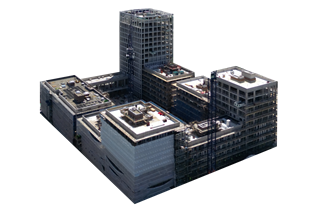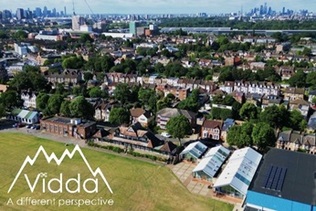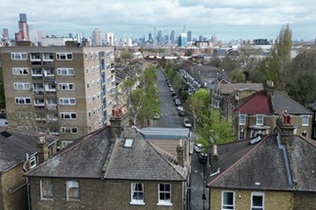Where Can I Fly a Drone in London? UAV Rules and Permissions in London

London drone restrictions: NATS (L) Drone Assist (R)
Updated 15th February 2025, by Jack
London Drone Regulations: A Comprehensive Guide
As drones become more common and integrated into everyday life, both recreational and commercial flights are increasing. However, the rules around drone flying can be complicated, with flight permissions depending on the type of drone, proximity to airports, potential hazards, and specific requirements set out by each borough. Drone regulations are constantly changing, and it is essential to stay up to date and follow the Civil Aviation Authority's (CAA) drone code of conduct at all times. For the latest information, refer to the CAA’s official website or their “Drone Safe” page.
CAA Rules
London is a bustling city, making it challenging to find locations that fall outside the CAA's restrictions on flying near built-up areas, which include residential, recreational, commercial, and industrial zones. For the purpose of this article, we'll focus on flying drones under 250g, which have more relaxed restrictions. For example, the DJI Mini series drones fall into this category and offer greater flexibility for urban flying. However, these drones must still maintain a safe distance from people and property, and operators must follow specific rules regarding flights over people and built-up areas.
Airports and NATS Restrictions
According to CAA rules, you cannot fly within the Flight Restriction Zone (FRZ) of an airport, which can extend up to 5km around airport runways. London has several airports, including Heathrow, Gatwick, and City Airport. Additionally, the London Heliport near Battersea and three restricted zones in central London add to the complexity. For a comprehensive overview of these zones, you can check out the NATS (National Air Traffic Services) website, which provides detailed maps and information on airspace restrictions.
Drone operators can apply for permission to fly within these zones, the table below lists the FRZs inside the M25 and the appropriate method to apply for permissions to fly a drone in these zones. Remember that if your application is approved you may still need to contact Air Traffic Control prior to flying. Note that the below list does not include prisons and Drone Assist applications may charge a fee.
| FRZ Name | Zone | Apply with |
|---|---|---|
| London Heliport | EGRU143 | Drone Assist |
| Hyde Park | EGR157 | NATS |
| City Of London | EGR158 | NATS |
| Isle Of Dogs | EGR159 | NATS |
| London City Airport | EGRU135 | NATS |
| Heathrow Airport | EGRU128 | NATS |
| RAF Northolt | EGRU129 | RAF Web Form |
| Denham Aerodrome | EGRU127 | Drone Assist |
| Elstree Aerodrome | EGRU131 | Elstree Web Form |
| Stapleford Flight Centre | EGRU136 | Drone Assist |
| Biggin Hill Airport | EGRU134 | Drone Assist |
| RAF Kenley | EGRU145 | Email RAF |
| The Specified Area | EGR160 | N/A to drones |
Local Bye-laws and Borough Regulations
Each borough in London has specific rules regarding drone flying and filming. Generally, these regulations are very strict, restricting flights in most areas. Finding detailed information online can be difficult, so a good starting point is contacting or checking the website of the borough's film office, especially if your drone flying involves filming. For central London areas, approval is governed by the City of London Police. Examples of strict boroughs include Westminster and Kensington and Chelsea, which have well-known restrictions on drone flights. For recreational flyers, the Richmond Park Flying Field stands out as one of the few areas with more relaxed regulations, additional information can be found in The Royal Parks Drone Policy.
Hazards and Obstacles
Flying near or over hazardous infrastructure such as electricity pylons, train lines, or cranes is dangerous and requires careful planning. Permissions may be required from relevant authorities, such as Network Rail if flying near train lines. Always consider potential hazards when planning your flight to ensure safety and compliance with regulations. Additional hazardous areas to avoid include schools, hospitals, and large public gatherings.
Take-off Point
It's crucial to have permission from the landowner where you plan to take off. This could be a local council, a private individual, or a business. Always seek and secure permission before launching your drone to avoid legal issues and ensure a smooth flight. This includes public parks and other common areas where people might assume they have automatic permission to fly.
Drone Assist
Given the numerous rules and pre-flight checks required, planning a drone flight can seem daunting. Fortunately, apps like Drone Assist from Altitude Angel consolidate information and provide a visual map of drone restrictions and hazards. However, there are some limitations to note:
- Specified Area (EGR160)
This large area covering most of London applies only to helicopters and not to drones like the DJI Mini. While this area appears on the Drone Assist map, it does not apply to drones, which is a relief for drone operators.
- Council Bye-laws and Take-off Permissions
Drone Assist is excellent for identifying hazardous areas, but it does not provide information on local council bye-laws or take-off permission requirements. Additional research is still necessary to ensure full compliance.
Key Takeaways for Safe Flying
Drones offer significant benefits for both businesses and hobbyists, but staying compliant with regulations is essential. At Vidda, we know that navigating London’s complex drone laws can be challenging. That’s why, in addition to this guide, we offer drone consultations to help businesses and individuals understand and comply with the rules.
Our consultations can cover:
- FRZ applications – Step-by-step guidance on securing permissions for specific sites
- Regulations, training & insurance – Answers to any questions you may have
- Operational guidance – Best practices for safe and legal drone use
To ensure an interactive experience, sessions are conducted online with screen sharing, or we can visit you on-site for more tailored guidance. To book a session, reach out using the contact details below.



